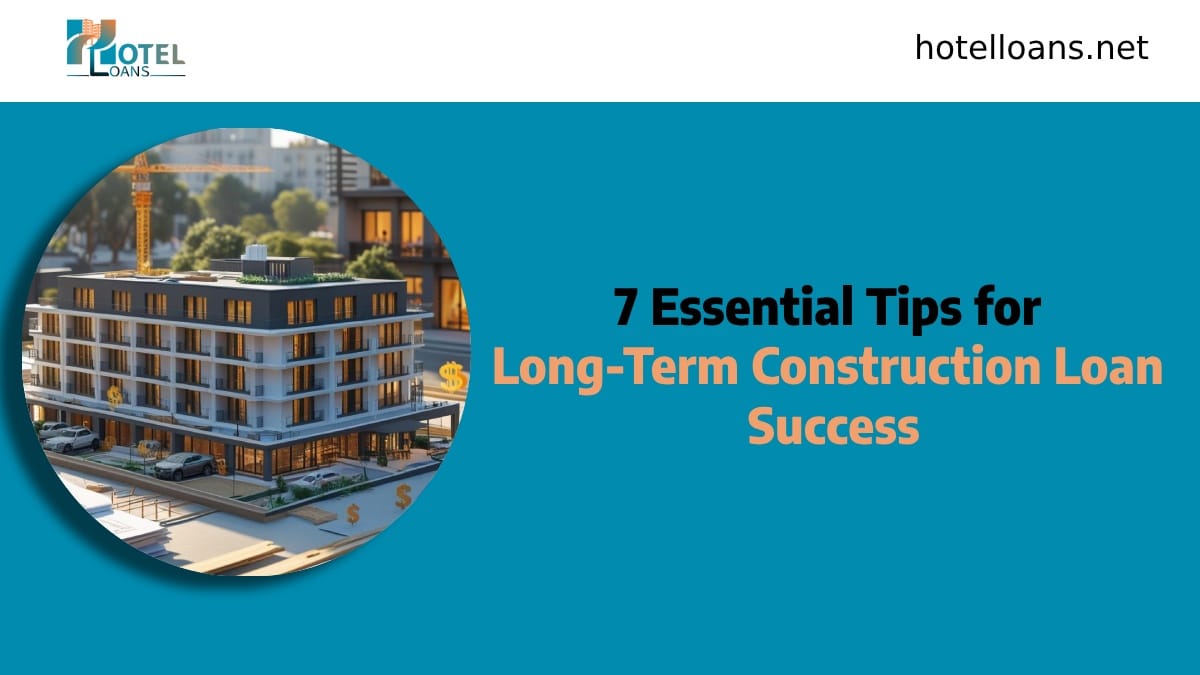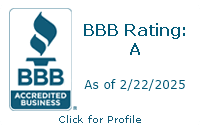It’s great to run a successful hospitality business, such as a small hotel, a busy restaurant, or a cozy vacation rental. The market for hotel real estate has considerable potential. Still, it can be challenging to determine how to finance it, especially for new construction projects.
In this case, the “long-term construction loan” is significant for making these big projects happen. It’s not just a means of financing the construction; it’s also a way to ensure that your project remains viable and thriving in the long run.
Many people who want to invest in hospitality real estate struggle to understand how construction financing works fully. This article will explain in 7 essential steps how to get and handle your “long-term construction loan,” which will help you succeed in the long run.
We’re here at HotelLoans.Net to help you through the whole process. We help people get loans for hotel real estate as correspondent and table lenders. We are backed by 30 years of experience in underwriting and an extensive network of clients. We fully understand the unique financial needs associated with investing in hospitality sites, and we’re here to help you bring your dreams to life.
Table of Contents
ToggleUnderstanding the Core: What is a Long-Term Construction Loan?
What Defines a Long-Term Construction Loan?
It’s essential to know your financing choices if you want to start construction new hospitality real estate. Consider the two main types of loans. The first is a loan just for construction. This is a short-term borrowing that will be used to finance the construction. Once the construction is done, the construction loan will need to be changed to a fixed mortgage. You may have more choices, but you may be at risk if interest rates change between the two parts of the loan. Additionally, you typically incur extra costs at closing for the second debt.
The construction-to-permanent loan (C-to-P loan), on the other hand, is what we’re talking about here and is an integral part of a long-term construction loan plan. The idea behind a C-to-P loan is sound: the construction loan and the fixed mortgage are combined into one loan. This reduces paperwork, streamlines the process, and allows you to lock in your long-term interest rate immediately, which minimizes the risk that rates will change in the future. In the hospitality industry, where security and predictability are crucial, the C-to-P loan is often the best and most popular choice for achieving long-term business success.
Why Consider a Long-Term Construction Loan for Hospitality Real Estate?
Long-term construction loans are a crucial component in realizing large-scale hotel projects. The best thing about a “fix and flip,” “fix and hold,” or “fix and rent” plan is that it makes it easy to obtain funds for major repairs and new construction. You can use this loan to cover significant upfront construction costs that you wouldn’t be able to afford on your own.
These loans are necessary for individuals who wish to purchase hotels, motels, restaurants, exercise centers, vacation homes, and other types of specialized venues in the hospitality sector as a form of investment. They help builders bring new ideas to life or make significant changes to existing homes, ensuring they meet today’s standards and appeal to the right customers. This enhances the property’s market value and increases its long-term profitability.
Tip 1: Master Your Financial Blueprint for Long-Term Construction Loan Eligibility
If you want to get a long-term construction loan for your hospitality business, you need to have a strong financial past. You can think of your budget as the foundation for your loan application.
It’s your “credit score” that matters. Because there are risks associated with new builds, lenders scrutinize credit scores closely for long-term construction loans. A credit score in the excellent range (720+) or higher indicates that you are responsible with your finances and significantly improves your chances of securing favorable interest rates and terms. Lenders will see that you can be trusted to manage your finances responsibly.
Also, your “Debt-to-Income (DTI) ratio” is critical. This percentage indicates the portion of your monthly gross income allocated to paying off your bills. If your debt-to-income (DTI) ratio is low, it means you can easily make extra loan payments every month. A debt-to-income ratio (DTI) of less than 43% is typically what lenders look for. A debt-to-income (DTI) ratio of 36% or less is ideal for construction loans, as it indicates that the borrower has sufficient disposable income to repay the new debt.
On top of that, you should be ready for “higher down payment expectations.” construction loans typically require a larger down payment than regular mortgages, usually 20% to 30% or more of the total project cost. You should make a big down payment if you want the job. It reduces the lender’s risk, making your application more appealing. Along with covering the initial costs of construction, this upfront payment also helps with any problems that might arise.
Finally, it’s hard to stress enough how vital “contingency funds” are. In the construction industry, unexpected problems and delays are frequent occurrences. You need a substantial emergency fund, approximately 10–20% of the total project budget, to cover unforeseen costs without jeopardizing your project or loan return. This emergency fund is a must-have safety net that demonstrates to lenders your financial stability and preparedness.
Tip 2: Develop a Comprehensive Project Plan for Your Long-Term Construction Loan
If you want a long-term construction loan for your hospitality development, you must have a clear and detailed project plan. Lenders must be very clear about their goals and how they plan to achieve them.
First, you’ll need a detailed plan for the construction. This isn’t just a rough sketch; it includes detailed construction plans, blueprints, and a list of all the requirements for your hospitality property. Lenders want to see the whole plan for your construction project, from the base to the shingles. They can judge the project’s scope, design integrity, and compliance with relevant construction codes based on this detailed paperwork, which has a direct effect on the loan’s approval and terms.
Second, it’s essential to have correct cost estimates. Your application must include a detailed budget that outlines all the expenses you anticipate incurring for the construction project. This includes writing down everything from buying land (if needed) and preparing the site to supplies, labor, permits, connecting utilities, and even the furniture for the interior. Underestimating costs can cause significant problems during a project. Hence, a reasonable and well-researched budget has a direct impact on the loan’s ability to be repaid and when it will be paid out.
Third, make a schedule that you can stick to. Lenders will carefully review your planned project schedule, which should include precise due dates for construction draws, to ensure a thorough review. A plan that you can stick to shows that you understand how the construction process works. It gives the investor confidence that the project can be completed quickly and within the loan term, reducing the likelihood of delays and additional costs.
Lastly, a crucial part of your plan is assembling a team of experienced individuals. The lender is much less likely to lose money if they know that a proven and trustworthy general contractor, planner, and project manager are working on the project. Their history of successful projects and expertise in developing hotels and resorts give lenders confidence in the quality of the construction and the efficiency of the project management. Having a great team is often just as important as having good numbers.
Tip 3: Understand Loan Disbursements and Interest Payments for Your Long-Term Construction Loan
Understanding how the money from your long-term construction loan is released and how interest is accrued is an integral part of managing your finances effectively.
First, ensure you are aware of the draw dates. Long-term construction loans, especially the popular C-to-P option, are paid out in stages, which are often referred to as “draws.” This differs from a traditional mortgage, which provides a lump sum. Each draw is tied directly to the completion of a specific project milestone, such as finishing the foundation, framing, or roofing. This step-by-step process protects both the borrower and the lender. It ensures that the borrower has access to funds when needed and that the lender only receives payment when progress is proven and construction costs are met.
Lenders typically conduct checks before releasing each draw. These site visits are essential to ensure that the project has met the stated milestone and that the requested funds are sufficient to cover the work that has been done. This close supervision ensures that loan funds are used correctly for construction projects and prevents them from being misused or wasted.
Borrowers typically only pay interest on the money that has already been disbursed during the entire construction phase. One significant benefit of this structure is that it helps maintain a clear view of cash flow when the business isn’t yet generating revenue. You don’t have to pay the principal until the project is finished, which saves you a lot of money during the part that requires the most capital.
Lastly, one of the best aspects of the construction-to-permanent loan is that it facilitates a seamless transition to a permanent mortgage. The loan is immediately converted upon completion of the construction and receipt of all draws. Now, you start making monthly payments on the loan amount plus the agreed-upon long-term interest rate. These payments will include both the principal and the interest. This means you don’t have to go through separate renewals, which saves you time, money, and stress.
Tip 4: Research and Choose the Right Lender for Your Long-Term Construction Loan
Selecting the right lender is one of the most crucial steps in securing a long-term construction loan for a hotel project. There is a difference between providers, especially in this area.
It’s best to find expert lenders with a proven track record of lending for construction projects and hotels. There are specific issues, problems, and opportunities in this area that these lenders are aware of. This is because a regular bank may not fully understand how a hotel or restaurant generates revenue or operates. This is where a company like HotelLoans.Net, which has been in the insurance business for 30 years, comes in handy. Because we understand the exact metrics and risks associated with hospitality places, we can offer customized solutions rather than generic ones. As both correspondent and table lenders, we provide our customers with direct access to the decision-makers, which streamlines the process by eliminating intermediaries and expediting approvals.
Aside from focusing, you should also carefully compare the different loan products. In addition to construction-to-permanent loans, it’s helpful to be aware of other loan options. These include bridge loans for short-term gaps, hard money loans for quick cash, DSCR loans for properties that generate income, and even government-backed options such as USDA B&I loans, SBA loans, and FHA commercial property investment loans. Learn about term loans, no-doc loans, lite-doc loans, state-income loans, and FHA construction-to-permanent loans so you can make an informed choice.
To get the best deal on your money, carefully compare interest rates and fees. construction loans typically have higher interest rates because they involve more risk. However, you should compare initial fees, closing costs, and any other fees associated with the loan to fully understand the total cost of borrowing money. In some cases, better terms or lower fees can make up for a slightly higher interest rate.
Lastly, put the lender’s name and help first. Select a lender who is recognized for being easy to communicate with, responsive to customer needs, and willing to collaborate with you throughout the entire loan process. A good relationship with a lender can mean the difference between a project going smoothly and one that encounters unnecessary problems.
Tip 5: Mitigating Risks for Your Long-Term Construction Loan
To get a long-term construction loan for your hotel project, you need to lower your risks ahead of time. It is essential to anticipate potential problems in advance and have a plan in place for how to address them.
First, always have a substantial emergency fund on hand in case you need to cover an unexpected expense. At any time during a construction project, unforeseen problems can arise. Some of these problems include sudden price increases for supplies, sudden worker shortages, and delays caused by adverse weather conditions. A reserve fund, typically comprising 10–20% of the total project budget, serves as a safety net if something goes wrong. It keeps your project on track and your finances from getting too tight.
Second, builders must be carefully screened. The most important part of finishing your project is your contractor. Carefully check the sources, ensure the licenses are still valid, and verify that the insurance coverage is sufficient. A trustworthy, experienced, and financially stable builder is crucial for adhering to schedules, ensuring the project proceeds smoothly, and monitoring construction costs, all of which have a direct impact on the success of your loan.
Third, ensure that you have comprehensive insurance coverage for the entire construction process. General liability insurance and builder’s risk insurance are typically included in this coverage. Builder’s risk insurance protects against damage to the construction that may occur during its construction and completion. On the other hand, general liability insurance covers any harm or crashes that might happen on the project site. Getting the right insurance protects your investment and meets the requirements of your loan.
Finally, consider how you will begin. For projects such as “fix and flip” or “fix and hold,” it’s essential to have a clear plan for repaying the long-term construction loan once the construction is completed. This could involve having a solid plan for long-term funding, a clear marketing and sales strategy, or a detailed operational plan to generate sufficient revenue from the completed hospitality property. This plan demonstrates to your lender that you are a financially responsible individual.
Tip 6: Monitor Progress and Maintain Communication
Throughout the life of your long-term construction loan, it’s essential to have good oversight and clear communication. Being passive can lead to disagreements and delays that incur significant costs.
First, make regular visits to the page. Regularly checking on the progress of the construction is necessary to ensure that the work is proceeding according to the approved project plan and the set drawing schedule. If you notice differences early, you can avoid enormous cost overruns and delays, which will protect your investment and loan terms.
Second, ensure that you can communicate with both your lender and your worker at all times. Providing your lender with clear and timely reports on your progress and any issues that arise builds trust. They can avoid problems that might happen when loans are paid out. Similarly, communicating clearly and frequently with your provider ensures that everyone is on the same page and that issues are addressed before they escalate.
Lastly, ensure that you maintain accurate and thorough records. Keeping careful records of all costs, bills, change orders, and correspondence related to the loan and construction costs is crucial. This detailed paper record is beneficial for keeping track of your budget, resolving disputes, and providing the necessary proof during draw requests or audits, ensuring that your long-term construction loan proceeds smoothly.
Tip 7: Strategic Planning for Your Long-Term Construction Loan After Completion
When you finish construction, that’s not the end of your financial journey; it’s just the start of the operational part. For long-term success, you need to make plans for this period.
For people who have chosen the construction-to-permanent (C-to-P) loan, the change is intended to be seamless. When the job is done and inspected one last time, your loan turns into a lasting mortgage. After that, you’ll start making regular monthly payments that include both the principal and the interest, as agreed upon in your original loan deal. There is no longer a need for a separate funding process.
Suppose you choose a construction-only loan, on the other hand. In that case, you will need to get a different permanent mortgage after the construction is done. A new estimate of the finished hospitality property and a thorough underwriting process, similar to obtaining a regular mortgage, are part of this process.
Regardless of the type of loan you have, you need a thorough operating budget for the period after construction is complete for hospitality properties. To ensure you can continue generating income and easily cover both interest and principal payments, this budget must carefully project revenues, staffing costs, utilities, repairs, and all other operational expenses.
Lastly, it’s essential to have a strong marketing and rental plan. When it comes to hotel investment properties, achieving high occupancy rates or a quick sale is crucial for generating the cash flow necessary to pay off your long-term debt and reach your investment goals.
Conclusion
Securing a long-term construction loan for your hospitality real estate project may seem challenging. Still, you can make the process easier by learning how loans are disbursed, creating a detailed financial plan, selecting the right specialized lender, mitigating risks, closely monitoring progress, and developing long-term plans for the phase after construction.
Your goals in hotel real estate can become more than just dreams if you plan carefully, learn the process, and find the right partner. At HotelLoans.Net, our mission is to empower you. We can assist you with your finances, whether you’re a seasoned investor or just beginning your investment journey. If you would like to learn more about purchasing land, developing new hotels, or implementing fix-and-flip, fix-and-hold, or fix-and-rent strategies for any type of hospitality property, please contact us. As a table lender and an associate lender, we can help you. We have been underwriting for 30 years and have an extensive network of investors and loans. Let’s make your dream of being a host come true.
FAQs
Can I use a long-term construction loan for renovating an existing hospitality property, or is it only for new builds?
In addition to new construction, a long-term construction loan, especially a construction-to-permanent loan, is a great way to finance significant hospitality renovation properties that are already in use. This includes “fix and flip,” “fix and hold,” and “fix and rent” projects that need a lot of money to make improvements, bring the property up to date, or make it bigger. The loan provides them with the necessary funds for these significant changes, just as it does for construction from scratch.
What is “Loan-to-Cost (LTC),” and why is it essential for a long-term construction loan?
Lenders use the loan-to-cost (LTC) ratio as a key measure to determine the riskiness of a construction loan. It shows the loan amount as a percentage of the total project cost, which includes purchasing the land, construction it, paying for items such as permits and design fees, and any other associated costs. Lenders typically prefer a lower Loan-to-Value (LTV) ratio because it indicates the client is contributing more equity, which demonstrates a more substantial commitment and reduces the lender’s risk. Knowing your long-term capital (LTC) is crucial for determining how much money you can borrow and demonstrating that you have a financial stake in the project.
Does long-term development finance for boutique hotels or specialist leisure venues have particular requirements?
Yes, unique hospitality properties, such as boutique hotels, non-branded hotels, or specialized recreation places, may require extra attention. When it comes to niche ideas, lenders specializing in hospitality real estate often require a more thorough feasibility study to assess market demand, projected occupancy, and revenue streams. It’s even more important to include specific amenities and target customers in your comprehensive project plan if you want to convince lenders that the project will be successful and profitable in the long run.
How does a long-term construction loan account for potential cost overruns or delays during the construction period?
Long-term construction loans require additional funds in case the costs increase or the project takes longer than anticipated. As was already said, it’s essential to have a separate budget for accidents, which is usually 10 to 20 percent of the total project cost. Interest-only payments during the construction phase also help maintain cash flow in the event of delays. Lenders also check each draw before releasing the money. This helps ensure that the money is being used wisely and that progress is being tracked, which protects against enormous, uncontrolled costs that exceed the budget.
What “hidden costs” or fees should I be aware of when getting a long-term construction loan beyond the interest rate?
Besides the interest rate, it’s essential to look at other fees as well. Origination fees, which are a fraction of the loan amount that the lender charges to process the loan, appraisal fees, inspection fees for each draw, legal fees for loan paperwork, and commitment fees or unused line fees on the part of the loan that hasn’t been paid out yet. There may also be exit fees or prepayment penalties on some construction loans if you pay them off early. As mentioned, you need to carefully compare all these fees to understand the actual cost of your financing fully.






